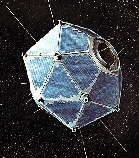The Vela-5B Archive

The Vela-5B archive includes :
High level products , lightcurves in FITS format and their plots
in GIF format, and the raw data in FITS format.
Both data sets are for the All Sky Monitor X-ray detector.
| Experiment |
Lightcurves |
Raw Data |
|---|
| All Sky Monitor |
FITS, GIF |
FITS |
The Vela-5B lightcurves can be obtained via the database Vela5b
available from
Browse.
Lightcurves and the raw data can be directly retrieved from the
Vela-5B FTP area
at the HEASARC archive.
 High level Products :
Lightcurves have been extracted for 99 known X-ray sources.
The lightcurves for 35 sources in unconfused areas of the sky were
generated both in a natural binning format (roughly 56 hours) and with the
original 1 second time resolution. The lightcurves generated by deconvolving
source contributions from crowded regions are in 112 hour bins.
The lightcurves are available in the 3-12 keV and 6-12 keV energy band.
High level Products :
Lightcurves have been extracted for 99 known X-ray sources.
The lightcurves for 35 sources in unconfused areas of the sky were
generated both in a natural binning format (roughly 56 hours) and with the
original 1 second time resolution. The lightcurves generated by deconvolving
source contributions from crowded regions are in 112 hour bins.
The lightcurves are available in the 3-12 keV and 6-12 keV energy band.
 Raw data:
There are two sets of Vela-5B raw data, one ordered by time and
the other by coordinates. The FITS layout consists of one extension
bintable containing the scientific data, pointing information and
other parameters.
A small portion (~0.1%) of the Vela-5B raw data was corrupted during
transfer from a Cyber 725 to VAX computer at Los Alamos labs in 1986.
The complete list of corrupted points is available in the file
all_bad.dat (~8 Mb) in the Vela-5B FTP area at HEASARC.
Raw data:
There are two sets of Vela-5B raw data, one ordered by time and
the other by coordinates. The FITS layout consists of one extension
bintable containing the scientific data, pointing information and
other parameters.
A small portion (~0.1%) of the Vela-5B raw data was corrupted during
transfer from a Cyber 725 to VAX computer at Los Alamos labs in 1986.
The complete list of corrupted points is available in the file
all_bad.dat (~8 Mb) in the Vela-5B FTP area at HEASARC.
Time ordered data
The corruption-free time ordered data is available in FITS format on the
Legacy computer in the
Vela-5B raw data area. Files cover the entire ten
year mission and have been split so that a single file covers five mission
days. These files have also been ingested at the National Space Science
Data Center (NSSDC).
Coordinate ordered data
The corruption-free coordinate ordered data are available in FITS format
on the Legacy computer in the
Vela-5B raw data
area. The celestial sphere
has been divided into approximately 12,000 boxes, most containing roughly a
2 deg x 2 deg area of sky.
 Software:
The software package Vela5b , distributed with the FTOOLs,
includes 5 tasks which allow to extract lightcurves from the raw data files.
The
fvelalc
generates a pair of light curves (one for each of the two
detectors, usually referred to as Channel 1 and Channel 2) for a specified
source which is in an unconfused region of the sky. For previous users of the
raw binary data, fvelalc replaces the programs SVELA and BINIT.
The velabox determines which raw data files are required.
Software:
The software package Vela5b , distributed with the FTOOLs,
includes 5 tasks which allow to extract lightcurves from the raw data files.
The
fvelalc
generates a pair of light curves (one for each of the two
detectors, usually referred to as Channel 1 and Channel 2) for a specified
source which is in an unconfused region of the sky. For previous users of the
raw binary data, fvelalc replaces the programs SVELA and BINIT.
The velabox determines which raw data files are required.
The fvelmap
and fvelgallc programs combined perform the
comparable function for crowded fields. Fvelmap computes a binned
map of the region around the source
of interest, fvelgallc uses this map to subtract the contributions of
neighboring sources to the lightcurve. For previous uses of the raw binary
data, fvelmap replaces NOD2D and FVELGALLC replaces NUSRC.
The velamap determines which raw data files are require.
[Vela-5B Home]
[About Vela-5B]
[Archive]
[Gallery]
[Publications]
Page authors: Lorella Angelini Jesse Allen
HEASARC Home |
Observatories |
Archive |
Calibration |
Software |
Tools |
Students/Teachers/Public
Last modified: Friday, 25-Sep-2020 16:47:43 EDT
| 

